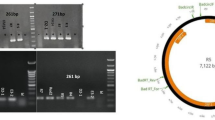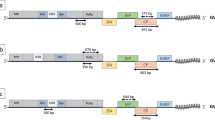Abstract
The high-yielding Cabernet Sauvignon grape variety is susceptible to viral diseases, which may influence the agrobiological and taste characteristics of its quality. The objectives of this study are to identify a Cabernet Sauvignon variety of clonal origin from the south of Ukraine, detect the infection of plants of this variety with harmful grape viruses incorporated into the certification system of planting materials, determine the causative agent of viral diseases by biomolecular methods, and establish the nucleotide sequence of the 2CCP envelope protein gene of detected grape viruses. As a result of phytosanitary survey, some Cabernet Sauvignon grape bushes of clonal origin with symptoms of grapevine fanleaf virus (CFLV) and grapevine leaf roll-associated virus (GLRaV) have been revealed. The results of grape virus identification by the real-time reverse-transcription polymerase chain reaction (RT-PCR) have demonstrated the presence of grapevine fanleaf virus in grape plants with infection symptoms. As a result of sequencing, it has been established that the nucleotide sequence of an isolate from the Cabernet Sauvignon variety is very close to the samples from regions geographically distant from Ukraine, first of all, the United States, Iran, and France. Based on microsatellite analysis, it has been proven that specifically the Cabernet Sauvignon variety of clonal origin is infected with grapevine fanleaf virus. The obtained 2CCP envelope protein gene sequence has been deposited with the international GenBank database with no. MN072356.1.






Similar content being viewed by others
REFERENCES
Almeida, R.P.P., Daane, K.M., Bell, V.A., Blaisdell, G.K., Cooper, M.L., Herrbach, E., and Pietersen, G., Ecology and management of grapevine leafroll disease, Front. Microbiol., 2013, vol. 4, p. 94. https://doi.org/10.3389/fmicb.2013.00094
Audeguin, L., Forget, D., Lusseau, T., Dufour, M.-C., and Lusson, A., GLRaV-2 Sanitation and performance of emblematic French clones of Cabernet-Sauvignon, Proc. 17th Congr. Int. Council for the Study of Virus and Virus-like Diseases of the Grapevine (ICVG), Davis: Univ. of California, 2012, pp. 154–155. https://icvg.org/data/ICVG-2012-Proceedings.pdf.
Bowers, J. and Meredith, C., The parentage of a classic wine grape, Cabernet Sauvignon, Nat. Genet., 1997, vol. 16, pp. 84–87. https://doi.org/10.1038/ng0597-84
Cauduro Girardello, R., Cooper, M.L., Lerno, L.A., Brenneman, C., Eridon, S., Sokolowsky, M., Heymann, H., and Oberholster, A., Impact of grapevine red blotch disease on Cabernet Sauvignon and Merlot wine composition and sensory attributes, Molecules, 2020, vol. 25, no. 14, p. 3299. https://doi.org/10.3390/molecules25143299
Dimovska, V., Sofijanova, E., and Fidanka, I., Agro-biological characteristics of three Sauvignon blanc (Vitis vinifera L.) clones, growing in R. Macedonia, Sci. Technol., 2013, vol. 3, no. 6, pp. 9–14. https://eprints.ugd.edu.mk/id/eprint/6958
Fuchs, M., Grapevine viruses: a multitude of diverse species with simple but overall poorly adopted management solutions in the vineyard, J. Plant Pathol., 2020, vol. 102, pp. 643–653. https://doi.org/10.1007/s42161-020-00579-2
Golino, D.A., Wolpert, J., Sim, S.T., Benz, J., Anderson, M., and Rowhani, A., Virus effects on vine growth and fruit components of three California ‘Heritage’ clones of Cabernet Sauvignon, Proc. 2nd Annual National Viticulture Res. Conf., Davis: Univ. of California, 2008, pp. 30–31 https://iv.ucdavis.edu/files/108857.pdf.
ISO 16578:2013, Molecular biomarker analysis – General definitions and requirements for microarray detection of specific nucleic acid sequences. https://www.iso.org/standard/57185.html.
Kumar, S., Stecher, G., Li, M., Knyaz, C., and Tamura, K., MEGA X: Molecular Evolutionary Genetics Analysis across Computing Platforms, Mol. Biol. Evol., 2018, vol. 35, no. 6, pp. 1547–1549. https://doi.org/10.1093/molbev/msy096
Mannini, F. and Digiaro, M., The effects of virusesand viral diseases on grapes and wine, in Grapevine Viruses: Molecular Biology, Diagnostics and Management, Meng, B., Martelli, G., Golino, D., and Fuchs, M., Eds., Cham: Springer-Verlag, 2017, pp. 453–482. https://doi.org/10.1007/978-3-319-57706-7_23
Martínez, L.E., Cavagnaro, P.F., Masuelli, R.W., and Zúñiga, M., SSR-based assessment of genetic diversity in South American Vitis vinifera varieties, Plant Sci., 2005, vol. 170, no. 6, pp. 1036–1044. https://doi.org/10.1016/j.plantsci.2005.12.006
Miljanić, V., Jakše, J., Kunej, U., Rusjan, D., Škvarč, A., and Štajner, N., Virome status of preclonal candidates of grapevine varieties (Vitis vinifera L.) from the slovenian wine-growing region primorska as determined by high-throughput sequencing, Front. Microbiol., 2022, vol. 13, p. 830866. https://doi.org/10.3389/fmicb.2022.830866
Milkus, B.N., Konup, L.A., Zhunka, I.D., and Limanska, N.B., Testing of some grapevine cultivars for the presence of Crown Gall disease agent and Fanleaf and Leafroll viruses, Mikrobiol. Zh., 2005, vol. 67, no. 1, pp. 41–48 (In Ukrainian). http://dspace.onu.edu.ua:8080/bitstream/ 123456789/21393/1/41-48.pdf.
OIV-CST 518-2016 (2016) OIV General Principles of Sustainable Vitiviniculture-Environmental-Social-Economic and Cultural Aspects. http://www.oiv.int/en/ technical-standards-anddocuments/resolutions-of-the-oiv/resolution-cst.
Oliver, J.E., Vigne, E., and Fuchs, M., Genetic structure and molecular variability of Grapevine fanleaf virus populations, Virus Res., 2010, vol. 152, nos. 1–2, pp. 30–40. https://doi.org/10.1016/j.virusres.2010.05.017
Osman, F., Leutenegger, C., Golino, D., and Rowhani, A., Comparison of low-density arrays, RT-PCR and real-time TaqMan RT-PCR in detection of grapevine viruses, J. Virol. Methods, 2008, vol. 149, no. 2, pp. 292–299. https://doi.org/10.1016/j.jviromet.2008.01.012
Rowhani, A., Biardi, L., Johanson, R., Saldarelli, Zhang, Y.P., Chin, J., and Green, M., Simplified sample preparation method and one-tube RT-PCR for grapevine viruses, Proc. 13th Int. Council for the Study of Viruses and Virus-Like Diseases of the Grapevine (ICVG), Adelaide, 2000. https://icvg.org/data/abstra.pdf.
Schmitt, D.E., Comin, J.J., Sete, P.B., Trapp, T., Ambrosini, V.G., and Brunetto, G., Yield and grape must composition in ‘Cabernet Sauvignon’ grape vine subjected to potassium fertilization in high altitude soil, Revista Brasileira de Ciências Agrárias, 2020, vol. 15, no. 4, p. e7482. https://doi.org/10.5039/agraria.v15i4a7482
Sivolap, Yu.M., Verbitskaya, T.G., Prokopenko, S.N., and Tulaeva, M.I., Study of species DNA polymorphism in Vitits vinifera grapes, Cytol. Genet., 1992, vol. 26, no. 3, pp. 11–15.
Sudarshana, M.R., Perry, K.L., and Fuchs, M.F., Grapevine red blotch-associated virus, an emerging threat to the grapevine industry, Phytopathology, 2015, vol. 105, no. 7, pp. 1026–1032. https://doi.org/10.1094/PHYTO-12-14-0369-FI
Vlasov, V., Belous, I., Dzhaburiya, L., and Bulayeva, Y., Development model of winemaking regions in Ukraine, Agric. Sci. Pract., 2014, vol. 1, no. 1, pp. 53–61. https://doi.org/10.15407/agrisp1.01.053
Vondras, A.M., Minio, A., Blanco-Ulate, B., Figueroa-Balderas, R., Penn, M.A., Zhou, Y., Seymour, D., Ye, Z., Liang, D., Espinoza, L.K., Anderson, M.M., Walker, M.A., Gaut, B., and Cantu, D., The genomic diversification of grapevine clones, BMC Genomics, 2019, vol. 20, p. 972. https://doi.org/10.1186/s12864-019-6211-2
Funding
The study was performed within budget program no. 0116U001166 “Monitoring of Viral, Bacterial, and Phytoplasmic Diseases of Grapes in Ukraine to Find the Ways of Improving the Quality of Wine and Wine-Production Products to the Level of European Union Requirements for 2016–2020” of the Laboratory of Virology and Microbiology of the National Scientific Center Tairov Research Institute of Viticulture and Winemaking, National Academy of Sciences of Ukraine.
Author information
Authors and Affiliations
Corresponding author
Ethics declarations
The authors declare that they have no conflicts of interest.
This paper does not contain any studies on people and animals as objects.
Additional information
Translated by E. Glushachenkova
About this article
Cite this article
Kovaleva, I.A., Janse, L.A., Konup, L.A. et al. Detecting the Infection of the Cabernet Sauvignon Variety of Clonal Origin by Grape Viruses. Cytol. Genet. 56, 504–512 (2022). https://doi.org/10.3103/S0095452722060044
Received:
Revised:
Accepted:
Published:
Issue Date:
DOI: https://doi.org/10.3103/S0095452722060044




